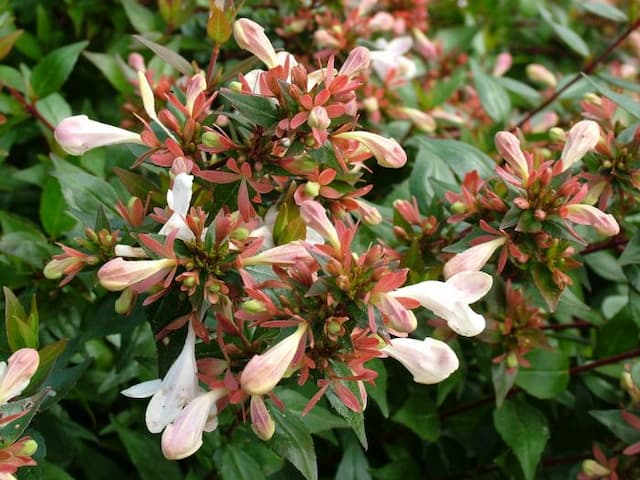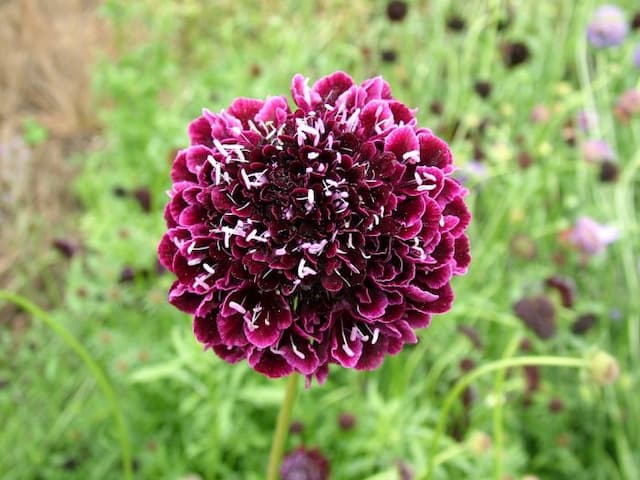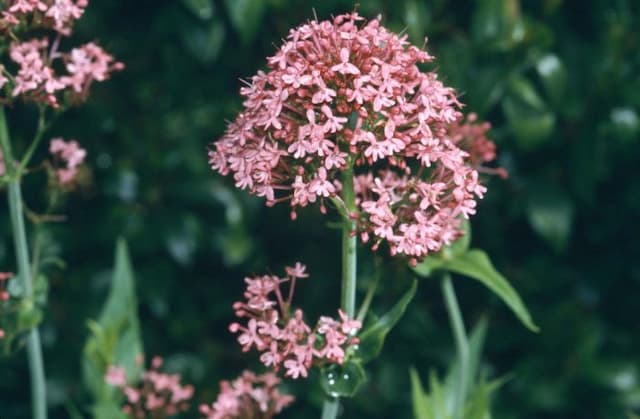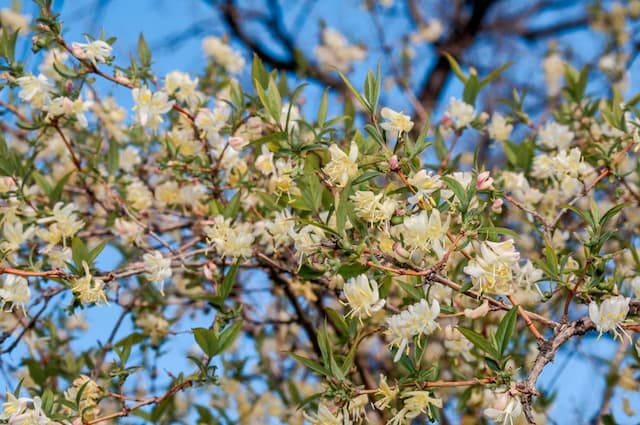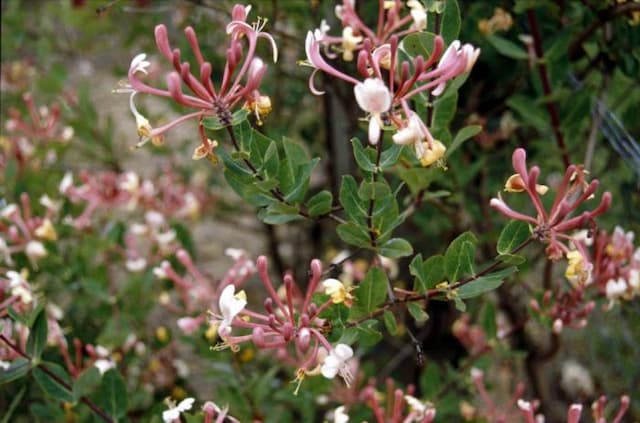Chinese Abelia Abelia chinensis R. Br.

ABOUT
Abelia chinensis, commonly known as the Chinese abelia, is a deciduous or semi-evergreen shrub that has a graceful, arching growth habit. Its branches are slender and often have a reddish tinge when young, maturing to a soft brown. The foliage consists of opposite, glossy, oval leaves that are typically a rich green color and may take on purplish hues in the fall before dropping. The Chinese abelia is notable for its profusion of small, funnel-shaped flowers that provide a showy display. These blossoms are typically white or pale pink, and they possess a delicate, sweet fragrance that attracts pollinators such as bees and butterflies. The flowers are often borne in clusters at the tips of the branches, creating a fine, airy texture. Following flowering, the plant may produce small, inconspicuous fruit that is not particularly decorative. Overall, the Chinese abelia is admired for its elegant form, attractive foliage, and beautifully scented flowers, making it a popular choice for ornamental gardens where seasonal changes in foliage and vibrant floral displays are desired.
About this plant
 Names
NamesSynonyms
Chinese Abelia, R.Br.
Common names
Abelia rupestris Lindl., Abelia uniflora R. Br., Abelia cavaleriei H. Lév., Zabelia dielsii (Graebn.) P. S. Hsu & H. Peng, Zabelia tyaihyoni (Nakai) P. S. Hsu & H. Peng, Zabelia biflora (Hance) Hisauti & H. Hara.
 Toxicity
ToxicityTo humans
The Chinese Abelia (Abelia chinensis) is generally not considered toxic to humans. There are no well-documented cases of poisoning or notable symptoms associated with ingesting this plant. However, as with any plant, individual allergies or sensitivities could potentially cause adverse reactions, and caution should always be exercised when dealing with unfamiliar plants.
To pets
The Chinese Abelia is not commonly known to be toxic to pets either. It is usually regarded as safe for dogs and cats, and there are no significant reports of pet poisoning from ingestion of this plant. As with humans, pets can have individual sensitivities, and it's always best to prevent pets from eating large amounts of any non-food plants to avoid potential stomach upset or other issues.
 Characteristics
CharacteristicsLife cycle
Perennials
Foliage type
Deciduous
Color of leaves
Green
Flower color
White
Height
3-5 feet (0.9-1.5 meters)
Spread
3-5 feet (0.9-1.5 meters)
Plant type
Shrub
Hardiness zones
7
Native area
China
Benefits
 General Benefits
General Benefits- Aesthetic Appeal: Adds visual interest to gardens with its glossy leaves, abundant flowers, and overall elegant appearance.
- Habitat for Wildlife: Provides shelter and food for various birds and beneficial insects, including pollinators like bees and butterflies.
- Drought Resistance: Once established, it can tolerate periods of low water availability, making it suitable for drought-prone regions.
- Low Maintenance: Requires minimal care once established, such as occasional pruning and watering, making it ideal for low-maintenance landscapes.
- Versatility: Can be used in a variety of garden designs, including borders, hedges, or as a standalone specimen plant.
- Seasonal Interest: Offers multi-season interest with spring to autumn flowers and potential winter foliage depending on the climate.
- Erosion Control: Helps prevent soil erosion when planted on slopes due to its root system stabilizing the ground.
- Easy Propagation: Can be easily propagated from cuttings, making it simple for gardeners to expand their plantings or share with others.
- Tolerance of Various Soil Types: Adapts to a wide range of soil conditions, though it prefers well-drained soils.
 Medical Properties
Medical PropertiesThis plant is not used for medical purposes.
 Air-purifying Qualities
Air-purifying QualitiesThis plant is not specifically known for air purifying qualities.
 Other Uses
Other Uses- Butterfly Attraction: Abelia chinensis, commonly known as Chinese abelia, is often planted to attract butterflies due to its flowers which provide nectar.
- Hedging: This shrub is suitable for creating low, flowering hedges in gardens and parks.
- Privacy Screen: Because of its dense growth habit, Chinese abelia can be used to create a natural privacy screen in residential areas.
- Bonsai: With its small leaves and ability to tolerate pruning, Chinese abelia can be trained into a bonsai form.
- Topiary: The plant's growth can be shaped into various forms, making it a good candidate for topiary art.
- Slope Stabilization: The root system of Chinese abelia can help stabilize slopes and prevent soil erosion in landscapes.
- Fragrance: The flowers emit a light fragrance and can be used to naturally scent gardens and outdoor living areas.
- Bird Habitat: The dense foliage provides shelter for birds, and they can also feed on the plant's berries.
- Floral Arrangements: The long-lasting flowers and foliage of Chinese abelia can be used in cut floral arrangements.
- Pot Plant: Due to its moderate size, Chinese abelia can be grown in large pots or containers, suitable for patios and balconies.
Interesting Facts
 Feng Shui
Feng ShuiChinese Abelia is not used in Feng Shui practice.
 Zodiac Sign Compitability
Zodiac Sign CompitabilityChinese Abelia is not used in astrology practice.
 Plant Symbolism
Plant Symbolism- Harmony: Abelia chinensis, commonly known as Chinese abelia, often represents balance and harmony in the garden because of its symmetrical growth habit and consistent blooming.
- Adaptability: The Chinese abelia's ability to thrive in various soil types and weather conditions symbolizes flexibility and resilience in various circumstances.
- Beauty and Grace: With its elegant flowers and arching branches, the Chinese abelia embodies beauty and grace, reminding us to appreciate the simple elegance in life.
- Longevity: Given that this plant can live for many years with proper care, it is sometimes associated with long life and endurance.
- Renewal: As the Chinese abelia flowers from summer to fall, it can symbolize renewal and the ability to start anew since it provides prolonged interest in the landscape.
 Water
WaterChinese Abelia requires regular watering to maintain moist but not waterlogged soil, especially during the first growing season to establish a deep, extensive root system. After establishment, it can tolerate some drought, but it's best to water it when the top 3 inches of soil are dry. Water the plant thoroughly, using approximately 1 gallon of water per watering for every 3 feet of shrub height. During the growing season, weekly watering is recommended, and in periods of extreme heat or drought, the frequency may need to increase to twice a week.
 Light
LightChinese abelia thrives best in full sun to partial shade. A location that receives at least six hours of direct sunlight a day is ideal, but it can also perform well in light dappled shade. Avoid deep shade, as this can reduce the plant's flower production.
 Temperature
TemperatureChinese Abelia is a hardy plant that can tolerate a range of temperatures, but it performs best in temperate climates. It can usually withstand minimum winter temperatures down to around 5°F. However, the ideal temperature range for this plant is between 60°F and 85°F, where it can grow vigorously and produce abundant flowers.
 Pruning
PruningPruning Chinese Abelia is important to maintain its shape and to encourage bushier growth and more flowers. Prune in late winter or early spring before new growth begins. Cut back up to one-third of the oldest stems to ground level, and shape the remaining stems as needed. Pruning too frequently or too late in the season can reduce flower production.
 Cleaning
CleaningAs needed
 Soil
SoilChinese Abelia thrives in well-drained soil with a slightly acidic to neutral pH, roughly between 5.5 and 7.5. A soil mix consisting of loam, compost, and sand or perlite in equal parts would provide good drainage as well as necessary nutrients. Mulching can help maintain soil moisture and temperature.
 Repotting
RepottingChinese Abelia does not require frequent repotting and can be repotted every 2 to 3 years if it outgrows its pot or the soil becomes depleted. It is best to repot in the spring before the growing season begins.
 Humidity & Misting
Humidity & MistingChinese Abelia prefers moderate to high humidity but is quite adaptable to various humidity conditions. Providing a humidity level between 40% to 65% would be ideal for its growth.
 Suitable locations
Suitable locationsIndoor
Place in bright, indirect light with some direct sun.
Outdoor
Plant in sun to part-shade in well-drained soil.
Hardiness zone
7-9 USDA
 Life cycle
Life cycleAbelia chinensis, commonly known as Chinese abelia, begins its life cycle as a seed which, after a period of dormancy, germinates in favorable conditions of moisture and temperature. The seedling then develops into a young plant with a small root system and a few leaves, engaging in photosynthesis. As it matures, the plant grows more vigorously, developing a robust root system, extensive foliage, and woody stems, eventually reaching its full size and forming an upright, slightly arching shrub. The Chinese abelia enters the flowering stage in late spring or early summer, producing fragrant, tubular flowers that attract pollinators such as bees and butterflies. Following pollination, the flowers give way to small, inconspicuous fruit containing seeds, which are dispersed into the environment to begin a new life cycle. The plant's foliage may change color with the seasons, and as a perennial, it can live for several years, going through annual cycles of blooming and dormancy.
 Propogation
PropogationPropogation time
Spring to Summer
The most popular method of propagating Abelia chinensis, commonly known as Chinese Abelia, is through semi-hardwood cuttings. This typically occurs in late summer when the current year's growth has partially matured but is not fully hardened. To propagate, cuttings of about 4 to 6 inches (10 to 15 centimeters) are taken from healthy stems. The leaves on the lower half of the cutting are removed, and the cut end is dipped in rooting hormone to enhance root development. The cutting is then planted in a well-draining soil mixture. It should be kept consistently moist and in a warm spot with indirect sunlight until roots develop, after which it can be transplanted into the garden.
